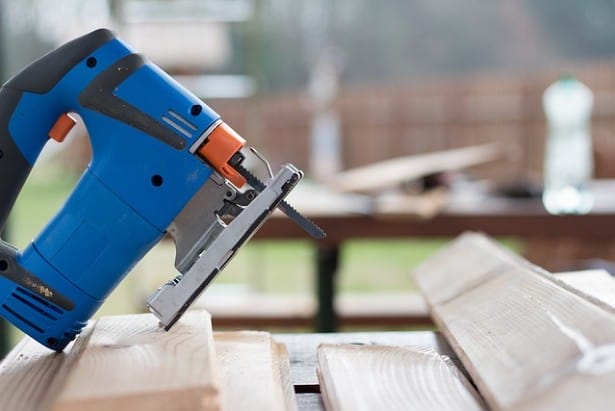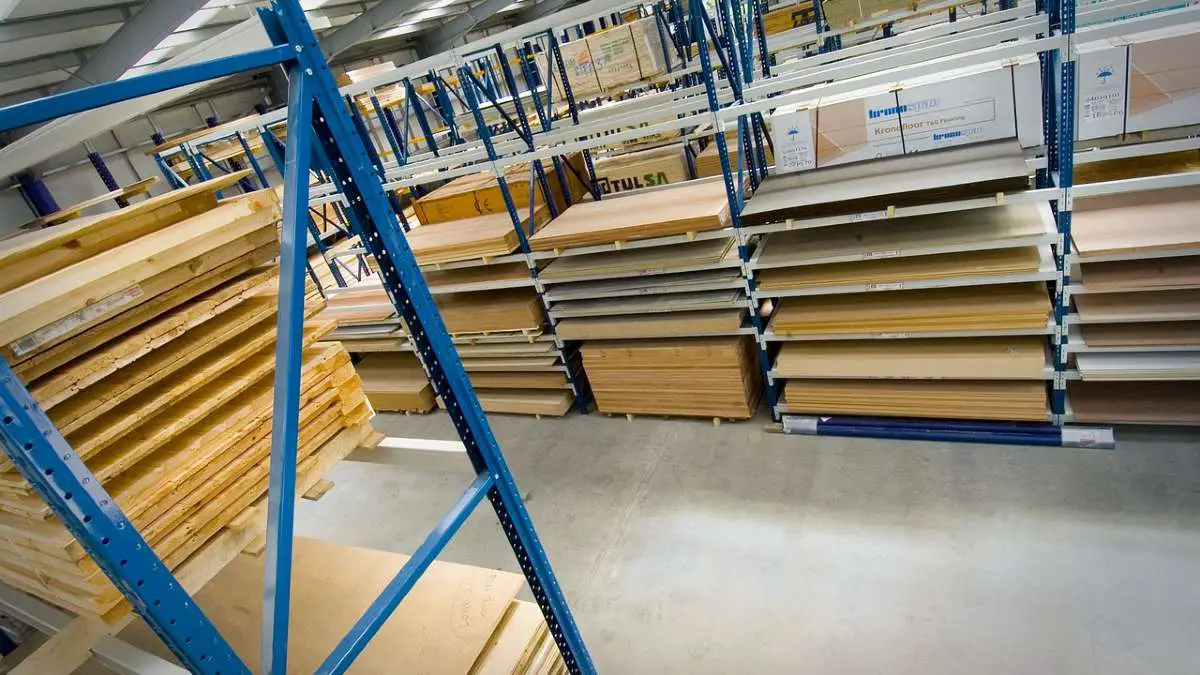When cutting plywood with a jigsaw it’s important to make accurate cuts, but sometimes it’s difficult to maintain control of the wood and keep it in straight lines. The most common mistakes I see when cutting plywood are usually due to inaccuracy caused by losing control of the wood. If you cut the wrong way; the face of your project will not look very appealing. If you spend any time cutting plywood with a jigsaw, here are some tips that might help you avoid making some common mistakes, saving you time and frustration down the road:
Picked The Wrong Saw
The jigsaw is a great tool for cutting curves, but it’s not the best tool for cutting straight lines. If you want to cut straight lines in your plywood, use a circular saw or a table saw.
If these tools are not available, you can certainly use a jigsaw. However, make sure that you use a guide against the base of the tool to keep the cut straight and free from curves.
The jigsaw is an excellent choice for cutting plywood with intricate curves on the edges because it’s a portable tool. If the sheet of plywood is large, it’s easier to cut out curves with a jigsaw than it would be with a scroll saw or bandsaw.
Splinters and Tear-Out
Plywood is an excellent material to work with; however, it is very susceptible to chipping and splintering. The best way to avoid these problems is to use a fine-tooth blade for your jigsaw. These blades are suited for cutting plywood surfaces because they easily create clean cuts without tearing or shredding the surface of the wood.
Many woodworkers make the mistake of trying to cut too large a piece of plywood in one pass. This can cause the blade to bind, resulting in kickback and dangerous flying splinters.
Keep The Jigsaw In Motion
If you keep your jigsaw in motion while cutting plywood, you are less likely to stray from the cutting line.
To make an accurate cut, the jigsaw blade must be in constant motion. If you start and then stop suddenly, your cut likely will be rough and ragged. When this happens, there’s little chance that you’ll get a clean cut.
There Are Two Sides To Every Story (The One You See And The One You Don’t)

When using a jigsaw on plywood, it’s important to remember that the tool cuts only on the top face of the board. If you only see the top surface, you don’t see the bottom.
You need to make sure that the blade doesn’t bash into something while it’s moving up and down. Otherwise, it could snap. Also, the saw could jump.
Also, you want to make sure it doesn’t cut into the workbench or some other object that it shouldn’t cut into.
Picked The Wrong Blade
The jigsaw is one of the most versatile saws you have in your workshop, but it can only give you good results if you pick the right blade. So, consider these things when choosing a blade for cutting plywood:
Material – The best material for cuts in wood is High Carbon Steel (HCS).
TPI – The TPI of the blade stands for the teeth per inch and ranges from about 5 to 24. A blade with a TPI of 6 makes an Aggressive cut through the wood. That is, it slices through the wood easily. Blades like this are commonly used in construction work.
The problem is that the cuts are not clean, there is tear-out and splintering. To reduce this, you should use a 10-TPI- to 12-TPI blade and go up to 20-TPI for tighter curves.
Cut Direction – Most jigsaw blades are made to cut on the upstroke. This happens when the sharp edges of the blade are pointed up. It results in a force pulling the tool base towards the plywood. However, there is often tear-out on the side that’s visible when the project is complete.
Reverse-tooth blades have teeth facing downward so that the tear-out is on the backside. At first, this seems good. However, the blade pushes the saw away from the plywood. As a result, the woodworker must hold the saw more firmly and may need to compensate by pressing down. This makes it much harder to make the cut and causes operator fatigue.
Length Of Blade – You want the length of the blade to be at least an inch or so greater than the width of the plywood you plan to cut.
However, the blade shouldn’t be too much longer or it will vibrate and overheat the motor. Also, it can bend or break.
The best thing to do is to test a new blade on non-critical cuts in scrap wood before you start your project. Also, keep the blade as sharp as possible.
Didn’t Use A Guide

There are two ways you can cut your plywood sheets: the right way and the wrong way. The right way is to use a guide to keep the jigsaw blade straight while cutting, while the other way is to use your hands or freehand it. Using a guide will ensure that your cut is straight and you spend less time sanding down the edges.
To do this, draw a line parallel to the cutting line and offset by the distance from the blade to the base of the saw. Then clamp a piece of scrap wood along that line. Run your jigsaw against it. The cut will be a straight line with no curves.
Also, you can use a large woodworking ruler in place of the scrap wood. This is one reason why a large ruler can be one of the most useful pieces of equipment in a woodworking shop. I describe it in the MUST HAVE tools section of this article.
Didn’t Account For The Kerf
When cutting plywood with a jigsaw, one of the most common mistakes is not accounting for the kerf. What’s the kerf? The kerf is the width of the material removed by the blade. This figure depends on the width of the blade and also the amount of wood “torn off” by the teeth.
Cutting With No Support Under The Plywood

It’s a lot easier to cut straight lines when you have something like a workbench or sawhorses holding up the plywood. Cutting plywood with no support will lead to lots of pieces that are not square and finished products that do not fit together as neatly.
You do not want your plywood shifting while you’re working on it, so be safe and make sure that you have something holding it in place before you start cutting it.
Saw Base Loose
Make sure the saw base is tightened in the proper position. In most cases you want the saw blade to be 90 degrees from the plywood. If the base is loose, you might end up making a bevel cut.
Measure Twice, Cut Once
This old proverb is certainly true in woodworking. To avoid wasting time and materials, it’s always a good idea to spend enough time making accurate measurements.
Extra Battery For Cordless Jigsaw
If you’re planning on cutting a lot of plywood at once, make sure you have an extra battery to ensure you don’t run out of power halfway through your project.
Personal Protective Equipment
If you are planning on cutting plywood with a jigsaw, always wear protective eyewear or goggles to shield your eyes from any small pieces of wood that might break off during the cut.
Plywood is a composite material made of thin layers of wood veneer. When cutting through the layers, fine dust particles can be generated. These particles irritate the eyes and lungs so it’s important to wear a respirator while using your jigsaw around plywood.
Wear ear protection when working with a jigsaw. The saw is very loud, and your hearing can suffer if you don’t wear a hearing protection device.
Cutting Too Fast
When cutting plywood with a jigsaw, one of the most common mistakes is pushing too hard on the blade with the motor. If you push too hard, the blade will break. The motor may also overheat.
Instead of forcing the blade, let the tool do the work.
Didn’t Replace Dull Blade

When cutting plywood with a jigsaw, one of the most common mistakes is not replacing a dull blade. The dull blade will make your cuts less accurate and can cause the wood to chip and splinter.
When cutting plywood with a jigsaw, always use a sharp blade designed for cutting wood. Dull blades will also increase the risk of kickback, which occurs when the tip of the blade catches on the wood and throws the machine towards you.
If you don’t replace a dull blade, you have to push harder on the saw so that the blade will bite into the wood.
Didn’t Use Clamps
When cutting plywood with a jigsaw, not using clamps is a common mistake. It’s easy to get impatient and try to hold the wood down with your hand. The problem with this approach is that any little bump or movement can throw off your cut, causing you to have to start over. If you clamp the sheet of plywood to your work surface, however, there will be no movement at all.
Cutting plywood projects with a jigsaw can be tricky. Holding the board in place while cutting is even trickier. Clamps are an essential part of the process.
For more information, see another article I wrote called: What is a JIgsaw?
Conclusion
This should help you understand the secrets to make consistently straight cuts and improve your overall cutting success. Following the steps above, you will be on your way to achieving straight, clean, and accurate cuts with a jigsaw instead of a sloppy, ragged mess.
Did you enjoy this article? If so, you might want to visit my boards on Pinterest. They contain pins about Woodworking, DIY & Crafts, Projects, Tools, and other topics.
Related Posts:
Can I Use A T-Shank Blade In A U-Shank Jigsaw?
How Long Does Shellac Take To Dry?
Can I Buy Exotic Woods Online?
Can An Electric Drill Be Used As A Screwdriver?
Can An Electric Drill Be Used As A Sander?



Admiring the time and effort you put into your website and in depth information you provide.
It’s nice to come across a blog every once in a while
that isn’t the same old rehashed information. Fantastic read!
I’ve saved your site and I’m including your RSS feeds to my Google account.
Thanks!